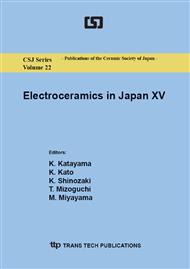p.145
p.149
p.155
p.159
p.163
p.167
p.171
p.175
p.179
Fabrication of BiFeO3-Bi(Zn1/2Ti1/2)O3 Solid Solution Thin Films Using Perovskite-Type Oxide Interface Layer
Abstract:
Bi-based perovskite-type oxide materials such as BiFeO3 (BFO) and Bi (Zn1/2Ti1/2)O3 and the related compounds receive much attention and have been developed actively as important candidates for Pb-free ferroelectric materials instead of toxic Pb-based perovskite oxide materials. Recently, many researches have been reported for thin films of Bi-based materials by various film-deposition techniques for actual application of semiconductive devices, microactuators, etc. In this study, we tried preferential crystal growth of BFZT films on semiconductive silicon substrates using uniaxial-(100)-oriented LaNiO3 (LNO) buffer layer. BFO films were fabricated via chemical solution deposition (CSD) technique on platinized silicon wafer [(111)Pt/TiO2/(100)S and (100)LNO-coated platinized silicon [(100)LNO/(111)Pt/TiO2/(100)S substrates. XRD analysis indicated that the films fabricated on (111)Pt/TiO2/(100)Si substrate consisted of randomly-oriented BFZT crystal with lower crystallinity. On the other hand, the films on (100)LNO/(111)Pt/TiO2/(100)Si consisted of uniaxial-one-oriented BFZT crystal with higher crystallinity. The crystallization temperature these films were 500°C, respectively. These results suggest that the BFZT crystal was grown successfully on uniaxial oriented (100)LNO plane which also had perovskite-type crystal structure. Consequently, one-oriented BFZT films were prepared on Si substrate successfully using (100)LNO buffer layer.
Info:
Periodical:
Pages:
163-166
Citation:
Online since:
July 2013
Authors:
Price:
Сopyright:
© 2013 Trans Tech Publications Ltd. All Rights Reserved
Share:
Citation:


